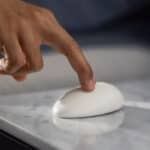Medical Disclaimer: The following content should not be used as medical advice or as a recommendation for any specific supplement or medication. It is important to consult your healthcare provider prior to starting a new medication or altering your current dosage.
Melatonin sleep patches are a new type of delivery system for melatonin that are applied to the skin in order to help people sleep. Melatonin is a hormone that regulates the body’s circadian rhythm, including the sleep-wake cycle. The brain releases melatonin when it’s dark, signaling that it’s time for bed and causing sleepiness.
Although melatonin is commonly taken in pill form, it can also be absorbed through the skin using an adhesive sleep patch. Melatonin patches have some advantages to oral pills as well as some side effects that you may want to learn about before trying them.
Does Melatonin Work in Patch Form?
Melatonin is a popular supplement that can help people with certain sleep issues, such as insomnia and jet lag, fall asleep. Many forms of melatonin have become commercially available, including pills, consumable liquids, and transdermal sleep patches. Sleep patches are applied to the skin and the melatonin is absorbed into the bloodstream.
Some research suggests that melatonin patches may help people stay asleep and have longer periods of rapid eye movement (REM) sleep. Compared to melatonin pills, the slower absorption rate of melatonin from sleep patches may be more effective at keeping people, such as shift workers, asleep during the daytime.
Sleep patches can contain different amounts of melatonin. Generally, patches with higher concentrations last longer. Melatonin patches can also be made with other ingredients, such as gels or alcohol, that may affect how much melatonin is absorbed by the skin. There is not enough research yet to recommend any specific ingredient for improving absorption.
How Do You Use a Melatonin Sleep Patch?
Most sleep patches are applied to the skin before bed and worn during sleep. Each brand has unique instructions on how to apply and dispose of them. Read and follow all directions written on the manufacturer’s label. Check the manufacturer’s label for how long a patch can safely be worn.
Follow these general steps to apply a melatonin sleep patch:
- Clean the area where you will apply the patch with soap and water. Pat the area until completely dry. Avoid using any lotion or creams in this area.
- Remove the patch from the packaging and peel off the adhesive protective layer.
- Press the patch firmly onto the skin for at least 30 seconds. Note that the exact timing may vary by brand.
- Ensure that the patch is properly attached by checking all the edges. If any type of skin irritation occurs after application, immediately remove the patch.
- Wash your hands after you are finished applying the patch to get rid of any residue or substances that may have come off the patch.
- When it’s time to remove the patch, gently peel it off and fold the edges together to seal it closed. Throw the patch in the trash.
What Are Melatonin Side Effects?
Melatonin is generally safe when taken in the short-term to help with sleep and has minimal side effects. Note that while the Food and Drug Administration (FDA) has regulations regarding dietary supplements, it does not approve supplements for safety and effectiveness of treating any specific disease or symptom.
Some people may experience side effects when they take higher doses of melatonin or extended release melatonin. These side effects include:
- Headaches
- Nausea
- Sleepiness during the day
- Tiredness
Since melatonin can cause tiredness, it is also best to avoid operating any machinery or driving until five hours after taking melatonin. There is no evidence that people who take melatonin develop a tolerance. Research has shown melatonin can be used safely for up to two years.
Some people may also experience minor skin irritation when using a transdermal patch. Certain brands may have ingredients that are less likely to cause skin irritation. Speak with your doctor if you have skin allergies or sensitivities before using a sleep patch.
Talk to your doctor before taking melatonin if you have any of the following:
- A bleeding disorder
- Depression or a mental health condition
- Seizures
- High blood pressure
- Plans to breastfeed an infant
- Previously had an organ transplant
Melatonin can sometimes cause more serious side effects in pregnant women or people with certain health conditions. Health experts recommend that people who are pregnant or trying to become pregnant should avoid taking melatonin.
Parents and caregivers should speak with their pediatrician before giving their child melatonin. Low doses taken in the short term may be safe, but there is some evidence that melatonin could affect children’s development.
Since melatonin sleep patches are a relatively new product, there is limited evidence about their side effects and safety. If in doubt, talk to your doctor before starting any new supplements.
Are There Benefits to Melatonin Sleep Patches?
Some people may benefit from using melatonin sleep patches instead of oral pills due to the unique delivery of melatonin through the skin.
Increased Bioavailability
When melatonin is absorbed directly through the skin from a patch, it bypasses the digestive system and goes directly into the bloodstream. This leads to greater bioavailability, or how much of a substance is successfully used by the body.
The time of day when melatonin is applied to the skin could potentially affect how much melatonin is absorbed. One study found that sleep patches applied in the daytime had better bioavailability than when applied at night, which may be helpful to those trying to get over jet lag or adjusting to a shift work schedule.
Slower Release Time
Melatonin comes in different formulations which may determine the rate at which melatonin is released. There are three different formulations that are typically sold including immediate-release, extended-release, and combined immediate and extended release.
Melatonin sleep patches are designed to provide an extended release of melatonin over a longer period of time than oral pills. This may help people stay asleep longer, especially during the daytime. Thus, melatonin patches may be a better option than oral pills for combating jet lag or for night shift workers who need to sleep during the day.
References
Ask the Sleep Doctor
Have questions about sleep? Submit them here! We use your questions to help us decide topics for articles, videos, and newsletters. We try to answer as many questions as possible. You can also send us an email. Please note, we cannot provide specific medical advice, and always recommend you contact your doctor for any medical matters.











































